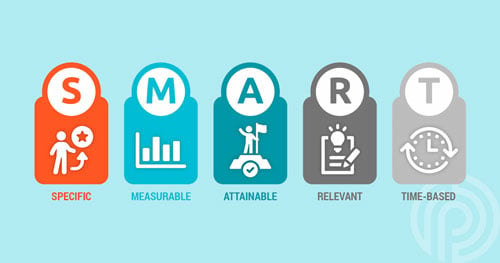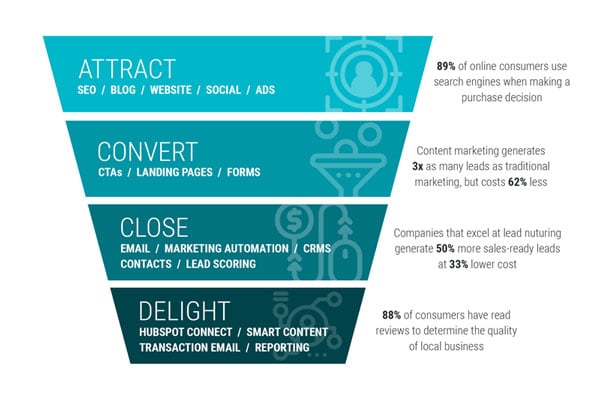Written By:
Kayley Blanchard
In this article we look at:
- Examples of SMART goals to guide your own efforts
- Resources that will help you achieve your goals
Key Takeaways
Define SMART goals: Make them Specific, Measurable, Attainable, Relevant, and Time-bound for clear direction.
Apply across marketing areas: Use SMART in content, SEO, social, lead gen, acquisition, and loyalty efforts.
Set metrics that matter: Tie goals to concrete numbers—traffic, rankings, engagement, leads, revenue—within deadlines.
Keep objectives business-aligned: Ensure every goal supports broader organizational growth and accountability.
Leverage supporting tools: Use templates, calendars, and guides to plan, track, and refine goal progress.
What Are SMART Goals?
SMART goals are Specific, Measurable, Attainable, Relevant, and Time-bound goals that outline what the goal is, how the goal will be met, and when it should be accomplished by.

What Are Some SMART Goals For Marketing?
Of course, all departments should be utilizing SMART goals, but they are particularly helpful for marketers. Here are some of the areas within inbound marketing that could benefit from the use of SMART goals.
- Content Marketing
- SEO
- Social Media Marketing
- Lead Generation
- Customer Acquisition
- Customer Loyalty

SMART goals provide a framework for your marketing efforts, maximizing your potential for success. They help create attainable goals, keep your team accountable, guide daily tasks, and make it easy to measure progress and success.
How To Set SMART Marketing Goals
Goals are what guide the day to day operations of every organization. Without them, employees would work aimlessly, never knowing what they should be doing or how to measure success.
.png?width=900&height=900&name=Regular-VS-SmartGoals-(1).png)
By integrating a SMART framework, everyone will not only be more productive but also have a clear understanding of the team's overall marketing strategy.
Download the S.M.A.R.T. Marketing Goals Template
An easy-to-use, free spreadsheet template with step-by-step instructions.
SMART Marketing Goals Examples
Below we explore 12 examples of SMART digital marketing goals that you may want to personalize and use to guide your own inbound marketing efforts.
- Double our website traffic over the next 12 months by publishing 5 high-quality, targeted blog posts per week.
- Redesign all blog content offer CTAs to increase CTR by 10% for the calendar year.
- Increase our rank in organic search results from 10th to 1st for the keyword “marketing goals” by the end of the month by optimizing existing content.
- Strengthen our backlink profile by obtaining 50 backlinks by the end of the month from authoritative domains via a link building email campaign.
- Boost our Instagram engagement rate from 4% to 5% in 30 days by publishing 15 high-quality images and/or videos optimized with relevant hashtags.
- Gain 1,000 new Twitter followers this quarter by posting educational content, statistics, and industry news that we know our audience engages with, at least once per day.
- Increase the number of MQL’s in our funnel by 10% by the end of Q2 via a targeted email campaign.
- Generate 500 qualified leads per month by implementing a targeted PPC campaign with a click-through rate (CTR) of 5%.
- Convert two qualified leads per month into buyers of X service so that we can generate $$ of monthly revenue.
- Boost our lead to customer conversion rate by 5% for the quarter by implementing a strong lead nurturing strategy which includes the publishing of targeted content aimed at our ideal buyers.
- Improve our customer retention rate by 5% for the year by implementing cross-selling and upselling strategies and offering bundled prices.
- Improve our Net Promoter Score (NPS) by 2 points for the calendar year so that we can improve our referral rate by 10%.
SMART Content Marketing Goals
If you’re a content marketer, you’re most likely tasked with planning and writing blog posts, developing effective CTAs, and promoting your content via multiple channels.
When setting your goals, it’s important to think about why you’re tasked with writing blog posts. The true purpose of blog content is to contribute to larger business objectives by increasing organic traffic and generating qualified leads.
That being said, SMART goals for your content marketing might look like this:
- Double our website traffic over the next 12 months by publishing 5 high-quality, targeted blog posts per week.
- Redesign all blog content offer CTAs to increase CTR by 10% for the calendar year.
Examples of marketing objectives to meet these goals might include:
- Identify relevant keywords to target in your blog posts with high traffic potential and low competition.
- Test different placements, sizes, copy, and designs on your CTAs.
SMART content marketing goals like these give you a clear plan on what kind of content to create and how to effectively measure its success over time.
Here are some resources to help you achieve your content marketing objectives and goals:
- How to Create Topic Clusters and Pillar Page Content: A Tactical Guide for Growth-Driven Marketers
- What is an Editorial Calendar? [And Why you Need One]
SMART SEO Goals
When it comes to SEO and improving your website’s visibility in search engine rankings, your daily tasks might include optimizing pages for search engines, identifying crawl issues, and link building.
By completing these tasks, you’re ensuring that your business’s website is strong enough to reach their ideal customers. When setting your SEO goals, keep in mind the relevance of your goals to the overall business objectives of traffic growth and lead generation. Overall, you want your SEO efforts to contribute to a positive ROI.
Some examples of SMART SEO goals are:
- Increase our rank in organic search results from 10th to 1st for the keyword “marketing goals” by the end of the month by optimizing existing content.
- Strengthen our backlink profile by obtaining 50 backlinks by the end of the month from authoritative domains via a link-building email campaign.
A couple of objective examples to reach these SMART SEO goals could be to:
- Update your content by optimizing your title, description, and header tags, as well as finding relevant keywords to target.
- Reach out to relevant high authority sites to guest blog with quality content in exchange for a link to your site.
Here are some resources to help you achieve your SEO goals:
- Why Isn’t My Content Indexed? 4 Questions To Ask Yourself
- A Beginner’s Guide to Fixing Errors in the New Google Search Console
SMART Social Media Marketing Goals
As a social media marketer, you’re often tasked with publishing content to various social media platforms, monitoring brand mentions, and overseeing paid social campaigns.
The overarching goal of your efforts is to increase brand awareness for your organization and generate quality leads that will ultimately convert.
Your SMART social media marketing goals might read like:
- Boost our Instagram engagement rate from 4% to 5% in 30 days by publishing 15 high-quality images and/or videos optimized with relevant hashtags.
- Gain 1,000 new Twitter followers this quarter by posting educational content, statistics, and industry news that we know our audience engages with, at least once per day.
Here are some examples of marketing objectives to meet your social media goals:
- Create relevant content to post that's educational or entertaining and engage with your audience.
- Use a social media content calendar to plan out and post relevant content daily on twitter.
Setting SMART goals like these create a clear marketing plan behind your social media efforts, giving each post a significant purpose.
Here are some resources to help you achieve your social media marketing objectives and goals:
- 5 Reasons Why Twitter Should Be a Part of Your Inbound Strategy
- How to Incorporate Social Selling into Your Sales Plan
SMART Lead Generation Goals
Marketers responsible for generating leads might perform tasks like creating targeted content, running targeted PPC campaigns, and email outreach.
Lead generation is a vital part of your organization’s most significant business objective: Increasing revenue. Keep this in mind as you set your lead generation goals so that you can determine which goals are the most valuable to pursue.
Some SMART lead generation goals to draw inspiration from are:
- Increase the number of MQL’s in our funnel by 10% by the end of Q2 via a targeted email campaign.
- Generate 500 qualified leads per month by implementing a targeted PPC campaign with a click-through rate (CTR) of 5%.
A few objective examples that help reach these SMART lead generation goals might be:
- Offer value through targeted emails with blogs, ebooks, and other resources used to educate leads.
- Setup URL tracking, identify what sites and keywords a lead came from, optimize for relevant keywords, and create relevant lading pages.
Here are some resources to help you achieve your lead generation goals:
- The Importance of Defining a Marketing Qualified Lead for Your Sales Process
- Buyer Persona Template: What Goes Into a Great Persona
SMART Customer Acquisition Goals
As a marketer concerned with customer acquisition, you’re the last piece in the puzzle before a deal closes. Thanks to your efforts, qualified leads become paying customers.
Your customer acquisition goals should be closely aligned with key business objectives and yearly revenue goals.
SMART customer acquisition goals might look something like this:
- Convert two qualified leads per month into buyers of X service so that we can generate $$ of monthly revenue.
- Boost our lead to customer conversion rate by 5% for the quarter by implementing a strong lead nurturing strategy which includes the publishing of targeted content aimed at our ideal buyers.
Ways to meet these goals could be to:
- Capture interest with discounts or giveaways and conduct follow-ups with leads via email or phone.
- Research your target audience, understand their pain points and use that to find content ideas and keywords to target.
Here are some resources to help you achieve your customer acquisition goals:
- Using Google Analytics for Conversion-Rate Optimization: A Step-By-Step Guide (Part 1 of 3)
- 6 Tools You Can Use to Gather Information on Your Inbound Leads
SMART Customer Loyalty Goals
Even though you’ve already acquired customers, the job of a marketer is never finished.
Customer loyalty can lead to a boost in revenue as your customers become your promoters. Satisfied customers are more likely to become repeat customers and tell others about your business.
SMART customer loyalty goals might look something like:
- Improve our customer retention rate by 5% for the year by implementing cross-selling and upselling strategies and offering bundled prices.
- Improve our Net Promoter Score (NPS) by 2 points for the calendar year so that we can improve our referral rate by 10%.
Some objective examples of customer loyalty goals might include:
- Streamline the checkout process, implement a rewards program, and engage with customers on social media.
- Identify customer needs, gather customer feedback, answer questions, and focus on delivering a better customer experience.
Here are some resources to help you achieve your customer loyalty goals:
- 3 Ways You Can Leverage Existing Customers to Find New Ones
- User-Generated Content: How to Turn Your Customers into Promoters
How To Create Your Own SMART Marketing Goals
The examples listed above are just a few of the many different measurable goals that you may want to set for your organization. Depending on the overall business objectives of your company, the metrics that make sense for you to improve upon will differ greatly. Take these business objectives into consideration when choosing the appropriate KPIs (key performance indicators) that you will track your goals against.
Regardless of your specific business goals, it’s imperative that these goals are SMART. Providing yourself and your team with clear and relevant goals, as well as a well-defined timeframe will boost overall productivity and keep everyone accountable for their actions.
With SMART goals in place, you’ll find it easier than ever to strengthen your inbound marketing efforts.
Use our free SMART goal setting template to get started.








